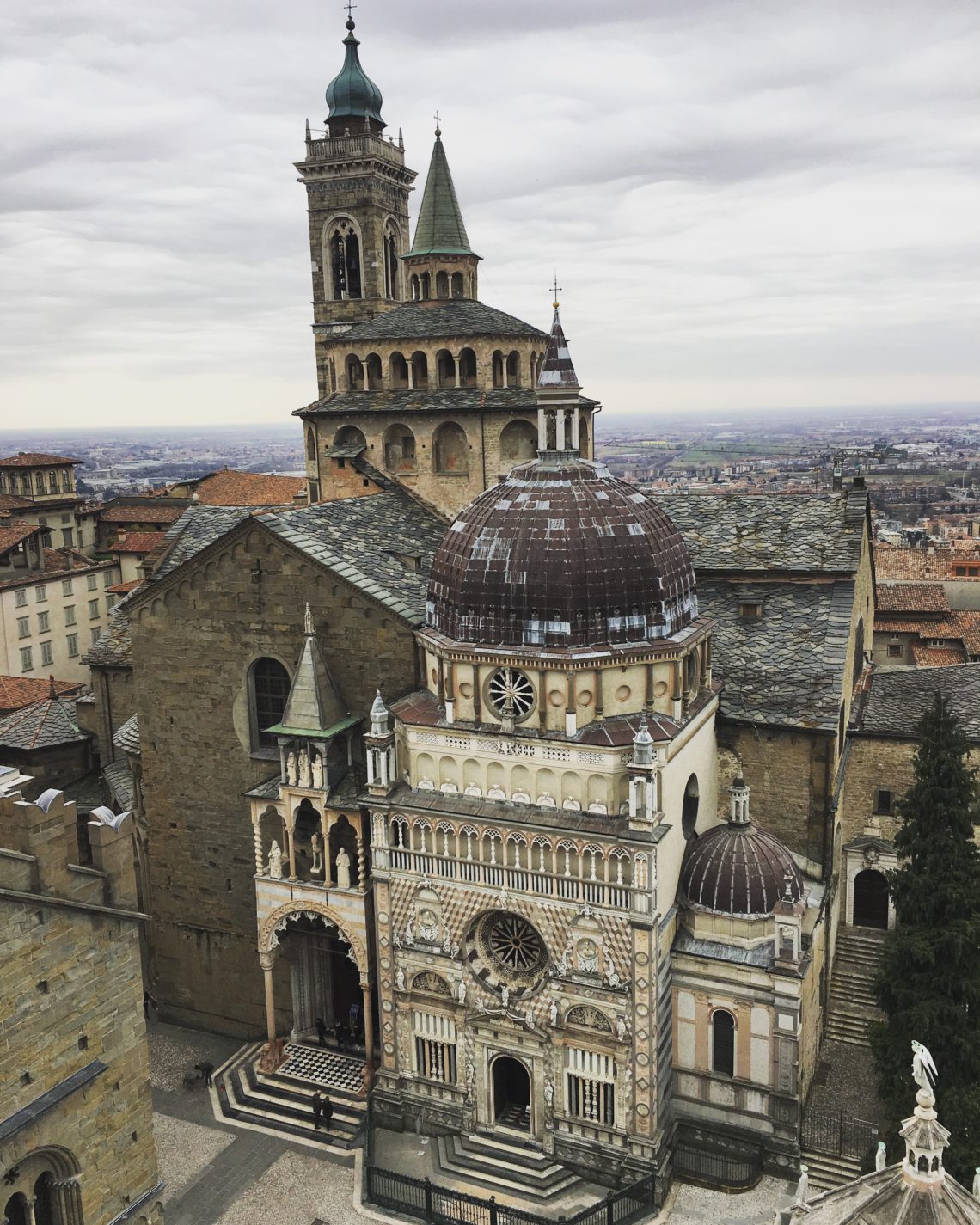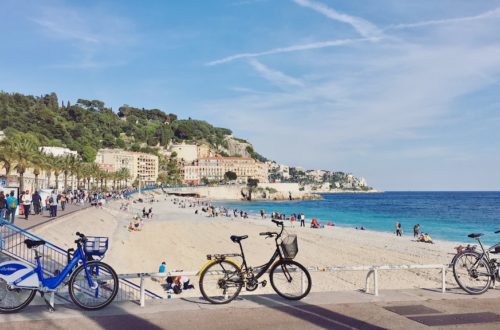I often get the urge to escape to smaller, slower-paced cities on the weekends. Milano has a ton of historical sites and gorgeous museums, but they’re more spread out around the city making visiting them a bit like a scavenger hunt. Plus there is an abundance of trendy, fashionable spots that make me think of the US (go home, Starbucks). So when I find myself with a free Saturday, I look at the map of Lombardy, choose a city I know nothing about, and head towards the central station to buy a ticket. I love strolling through Italian towns that are more compact, with all their rich histories condensed into a small city center.
After hearing a lot of good things about the city, I bought a round trip ticket from Milano Centrale to Bergamo for a whopping 11 euros. Forty eight minutes later, and I found myself strolling out of the Bergamo station.
The city is divided into two parts: the Città Alta and Città Bassa (literally the high city and the low city). I wanted to go towards the oldest part and soak up some culture so I spent most of my day in Città Alta, figuring I’d go back to explore the low city on another day trip.
Getting to La Città Alta:
Coming out of the station, you can easily reach the funicolare, which is a tram that takes you up to the high city, in about ten to fifteen minutes on foot. It’s a straight shot down the street. Head straight towards the McDonalds (please don’t go in) and continue on that street until the road curves to the right. Curve with it, and you’ll see the little station with the funicolare, which costs about 1 euro 30 cents for a one-way lift. If you would rather walk, there is a staircase to the left of the station, that takes about ten minutes to climb up and is really pretty! This is what I did. I would recommend this path because you also get to walk through the gorgeous Porta San Giacomo.
Porta San Giacomo is the oldest gate in the city. There’s a beautiful stone walkway that leads to the gleaming white, marble gate, built by the Venetians in 1537. You’ll see the blue mountains and an overview of La Città Bassa down below. From here, you can either stroll along the Venetian walls, which are a UNESCO World Heritage site, or cross the street at the crosswalk and head straight towards the town center. If you opted for the funicolare, you’ll be spat out in a sweet little piazza just a stone’s throw from the main square.
Piazza Vecchia
Bergamo really delivered on my order for “condensed history.” This is the oldest piazza in the city, completed in the mid 15thcentury, and you can easily spend your whole afternoon here. For years it was the government center. On the north side sits Palazzo Nuovo (the white building), which housed the Town Hall from 1614 to 1873, where important men clad in ridiculous tights came to discuss serious matters. On the south side is the Palazzo della Ragione (the one with the arches) and on the west is the residence of the Ventian Podestà (governor). The Palazzo contains a 16th century museum and interactive path to help take you back into old Bergamo, if you’re eager for more culture.
In the center, is a lovely white marble fountain, guarded by lions and snake-like creatures, which was donated by the governor Alvise Contarini in 1780. Bordering the piazza are a number of cafés with indoor and outdoor seating, perfect for grabbing a coffee or even lunch and people watching. Passing beneath the arches of the Palazzo della Ragione, you come upon a lovely cluster of two churches and a chapel that you must see. All are free to enter, and absolutely breathtaking.
Cattedrale di Sant’Alessandro (Duomo di Bergamo)
It’s the white one on the left. The Duomo was thought up by Carlo Fontana in 1688, but it wasn’t fully completed until 1886. The inside is strikingly beautiful with black and white checkerboad floors, pastel frescoed ceilings and gold detailing everywhere. Looks a lot like my studio apartment.
Basilica di Santa Maria Maggiore
Next door, sandwiched between the Duomo and the ornately decorated church, sits the humble Santa Maria Maggiore. You enter through the pink and white arch placed in front of an otherwise lackluster brown, stone church. But don’t be fooled. The inside will knock you out with its baroque stuccos, tapestries, and elaborate artwork everywhere you look. This is one of the most incredibly ceilings I’ve ever seen in a European church and I’m the kind of gal who pops into most of the churches I pass. Built in the second half of the 12thcentury, the outer gothic porticos were added on in 1351. The composer Gaetano Donizetti is buried inside.
Capella Colleoni
The most eye-catching from the outside, the chapel was commission in 1472 by Bartolomeo Colleoni, the Commander General of the Venetian Republic, and now stands as the best example of Renaissance architecture in Bergamo. The inside is small – it is a chapel after all – but contains frescoed lunettes, a lovely alter, and the tomb of Colleoni.
Torre Civica/Campanone
After I pinballed around the piazza, seeing everything there was to see, I decided to get a different perspective. I would highly recommend climbing up the Torre Civica in the square, which is the highest tower in Città Alta containing the largest bell of Lombardy. Every evening, it chimes at 10 pm, marking the town curfew of ages hence. I was the only person up there for a good five minutes, and I deliriously took in the views from every angle. You can enjoy an impressive panorama of the mountains in the distance, the Italian countryside, and an incredible bird’s eye view of the iconic churches down below. You can take the elevator or the stairs, but it isn’t too high so take the stairs! It’s 5 euros to visit both the tower and the museum of the Palace of the Podestà.
San Vigilo & La Rocca
If you’re a panorama junkie, you’ve got another climb to crank out. San Vigilo is a look out point and sort of “rock fortress” that dates back to the 14th century. You can take a second funicolare to the top or trudge up an inclined path. Up at the top of the hill, you’ll be met with another pretty view of Bergamo down below. Continue up to the Rocca, for a 360 view of the Upper Town, the Orobie Alps, and the skyline of Milan in the far distance. There is also a museum up there along with several little pizzerias and restaurants up in case you’ve worked up an appetite from all of the climbing. They say this spot merits a visit in the morning or at sunset, and it seemed like a good place to bring a panini and some drinks if you’re balling on a budget.
Museo Donizetti
If you’re a classical music buff, you’ll be wantin’ to head to the Museo Donizetti in the center of Città Alta, just down the cobblestone street behind Santa Maria Maggiore. Gaetano Donizetti (born 1797 in Bergamo) was a renowned composer in the European music scene during the early 19th century. He was among the three leaders of the ‘bel canto’ opera style along with Rossini and Bellini, and he proceeded to compose 71 operas before dying at age 50. Inside you can learn more about his life through letters, objects, scores, and more.
Pinacoteca dell’Accademia Carrara
This musuem is actually down in the Città Bassa part of the city, but is easily reachable on foot towards the end of your visit. I made it a point to head to this museum as it contains over 1,500 paintings dating from Renaissance art to modern art. Inside you’ll find masterpieces by Botticelli, Raphael, Titian, Mategna, Canaletto etc. I’d allow for about 2 hours or more depending on how deeply you want to dive in, but this museum is a must-see for art lovers passing through bella Bergamo.
These are my top picks for a day spent in La Città Alta of Bergamo. Stay tuned for my next visit, and we’ll talk about what to see in La Città Bassa. Make sure you take time to simply explore the city streets, put your phone on airplane mode, and take it all in.
Xo,
Megan




